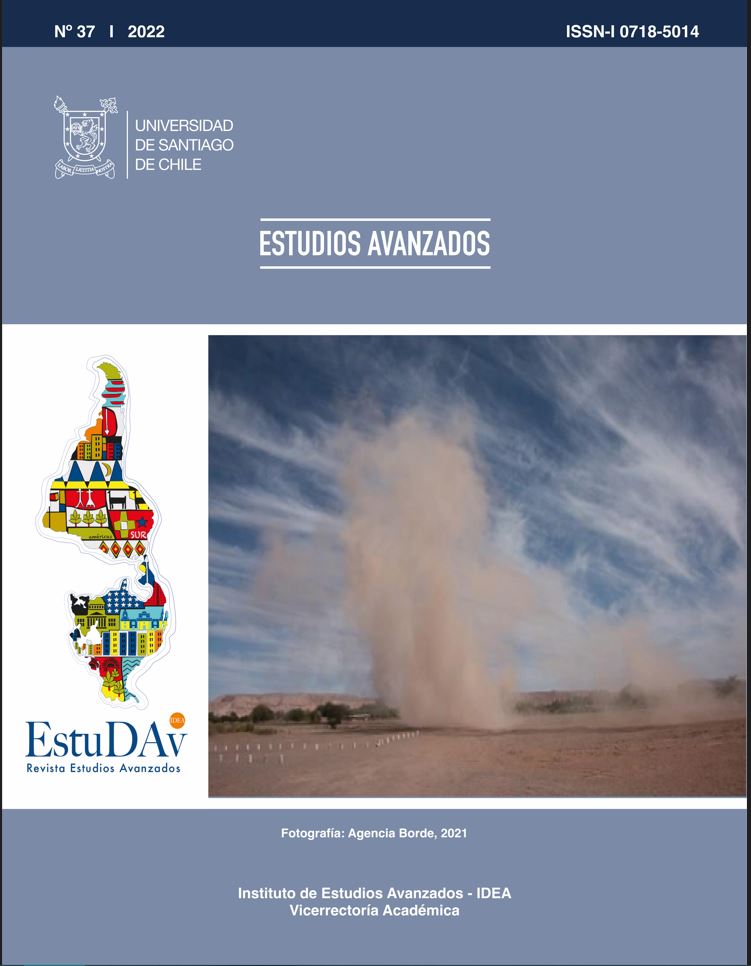A Geopolitical Imagination with Chinese Characteristics: Analysis from American Studies of the Evolution of China’s Foreign Policy in its Geopolitical Projects
DOI:
https://doi.org/10.35588/estudav.v0i37.5829Keywords:
China, geopolitical imagination, geopolitical codes, Chinese foreign policy, China-Latin America relationsAbstract
This article analyzes, from the American studies, and through a theoretical and discursive review, the evolution of China’s geopolitical imagination as an approach to Critical Geopolitics. It is worth asking how this dimension has conditioned Chinese foreign policy in its international insertion in the last two decades. It is hypothesized that the changes in the geopolitical imagination in China materialize in differentiated geopolitical codes and two moments. The first moment corresponds to the period between 1990 and 2008, with a foreign policy whose axis was to maintain a low political profile and advance participation in international regimes and trade agreements; while the second moment is set from 2008, towards the end of the Hu Jintao administration and consolidated to the present with Xi Jinping, characterized by a more active and assertive foreign policy. It is a product of the transformation in its international reintegration strategy and the need to stabilize its entire geopolitical space, moving towards consolidating China’s status as a global power. At this moment, Latin America is established as a strategic region in the materialization and search for consolidation of its geopolitical imagination.
Downloads
References
Agnew, J. (2010). “Emerging China and Critical Geopolitics: Between World Politics and Chinese Particularity”. Eurasian Geography and Economics (51)5: 569-582. DOI https://doi.org/10.2747/1539-7216.51.5.569
____. (2009). Globalization and Sovereignty. Lanham, Rowman & Littlefield Publishers.
____. (2005). Geopolítica: una re-visión de la política mundial. Madrid, Trama.
Agnew, J.; Dalby, S.; Flint, C.; Mamadouh, V.; Newman, D. y Schofield, R. (2020). “Geopolitics at 25: An Editorial Journey through the Journal’s History”. Geopolitics 25(5): 1199-1227. DOI https://doi.org/10.1080/14650045.2020.1789802
An, N. (2020). Confucian Geopolitics. Chinese Geopolitical Imaginations of the US War on Terror. Singapur, Springer.
Center for International Knowledge on Development (2021). China’s Progress Report on Implementation of the 2030 Agenda for Sustainable Development. Beijing, Center for International Knowledge on Development (CIKD).
China Daily (2016). China’s National Plan on Implementation of the 2030 Agenda for Sustainable Development. Beijing, China Daily.
____. (2008). “Full text: China’s Policy Paper on Latin America and the Caribbean”, 06 de noviembre 2008. China Daily. En https://www.chinadaily.com.cn/china/2008-11/06/content_7179488.htm (consultado 22/12/2022).
Jorquera, C. (2021). “El sistema Tianxia como vínculo clave entre China y América Latina”. Si Somos Americanos. Revista de Estudios Transfronterizos 21(2): 203-224. DOI https://doi.org/10.4067/s0719-09482021000200203
Fortín, C.; Heine, J. y Ominami, C. (2021). El no alineamiento activo y América Latina: Una doctrina para el nuevo siglo. Santiago, Catalonia.
____. (2020). “Latinoamérica: no alineamiento y la segunda”. Foreign Affairs Latinoamérica 2(3): 107-115.
Li, X. (2012). “China y el orden mundial capitalista: el nexo de la transformación interna de China y su impacto externo”. En Bernal-Meza, R. y Quintanar, V. Regionalismo y orden mundial: Suramérica, Europa, China. Buenos Aires, Nuevo Hacer-Grupo Editorial Latinoamericano: 29-53.
Ministry of Forgein Affairs of the People’s Republic of China (2011). “China Issues White Paper on Peaceful Development”, 07 de septiembre 2021. Beijing, Oficina de Información del Consejo de Estado de la RPC. En https://www.fmprc.gov.cn/mfa_eng/topics_665678/whitepaper_665742/t856325.shtml (consultado el 22/12/2022).
Murphy, D. (2022). China’s Rise in the Global South: The Middle East, Africa, and Beijing’s Alternative World Order. Stanford, Stanford University Press.
Narins, T. y Agnew, J. (2019). “Missing from the Map: Chinese Exceptionalism, Sovereignty Regimes, and the Belt Road Initiative”. Geopolitics 25(4): 809-837. DOI https://doi.org/10.1080/14650045.2019.1601082
Ó Tuathail, G. (2002). “Geopolitical Structures and Cultures: Towards Conceptual Clarity in the Critical Study of Geopolitics”. En Tchantouridze, L. (ed.). Geopolitics. Global Problems and Regional Concerns. Winnipeg, Centre for Defense and Security Studies: 75-102.
____. (1996). Critical Geopolitics. Londres, Routledge.
Ó Tuathail, G. y Agnew, J. (1992). “Geopolitics and Discourses. Practical Geopolitical Reasoning in American Foreign Policy”. Political Geography 11(2): 190-204.
Ó Tuathail, G. y Dalby, S. (2002). Rethinking Politics. Nueva York, Routledge.
Qin, Y. (2016). “A Relational Theory of World Politics”. International Studies Review 18: 33-47.
____. (2012). “Cultura y pensamiento global: una teoría china de las relaciones internacionales”. Revista CIDOB d’Afers Internacionals 100: 67-90.
____. (2010). “International Society as a Process: Institutions, Identities, and China’s Peaceful Rise”. The Chinese Journal of International Politics 3(2): 129-153. DOI https://doi.org/10.1093/cjip/poq007
Rodríguez, R. (2005). “Geopolítica Crítica: el Pacto Ibérico de 1939”. Scripta Nova 9(198): 181-204.
Rosales, O. (2020). El Sueño Chino. Cómo se ve China a sí misma y cómo nos equivocamos los occidentales al interpretarla. Santiago, CEPAL y Siglo XXI.
Ross, C. (2020). “Chile and China, 2000-2016: The Hummingbird and the Panda”. En Bernal Meza, R. y Li, X. (eds.). China-Latin America Relations in the 21st Century. The Dual Complexities of Opportunities and Challenges. Boston, Palgrave: 169-191.
State Council of the People’s Republic of China (2021). “Full text: China’s International Development Cooperation in the New Era”, 10 de enero 2021. State Council of the People’s Republic of China. En https://english.www.gov.cn/archive/whitepaper/202101/10/content_WS5ffa6bbbc6d0f72576943922.html (consultado 22/12/2022).
____. (2016). “Full text: China’s Policy Paper on Latin America and the Caribbean”, 24 de noviembre 2016. State Council of the People’s Republic of China. En http://english.www.gov.cn/archive/white_paper/2016/11/24/content_281475499069158.htm (consultado 22/12/2022).
Taylor, P. y Flint, C. (2002). Geografía política: economía mundo, Estado-nación y localidad. Madrid, Trama.
Tharoor, I. (2014). “Could this Map of China Start a War?”. The Washington Post, 27 de junio 2014. En https://www.washingtonpost.com/blogs/worldviews/wp/2014/06/27/could-this-map-of-china-start-a-war/ (consultado el 22/12/2022).
The Beijing News (2014). “竖版中国地图南海诸岛不再用插图表示”, 25 de junio 2014. The Beijing News. En http://epaper.bjnews.com.cn/html/2014-06/25/content_519902.htm?div=0 (consultado 22/12/2022).
Wendt, A. (1992). “Anarchy is What States Make of It: The Social Construction of Power Politics”. International Organization 46(2): 391-425. DOI https://doi.org/10.1017/s0020818300027764
Zhao, X. (2018). “In Pursuit of a Community of Shared Future. China’s Global Activism in Perspective”. China Quarterly of International Strategic Studies 4(1): 23-37. DOI https://doi.org/10.1142/s2377740018500082
Downloads
Published
Issue
Section
License
Copyright (c) 2023 Constanza Jorquera Mery

This work is licensed under a Creative Commons Attribution 4.0 International License.




